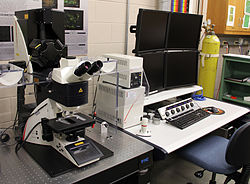Center for Biofilm Engineering
The center tackles biofilm issues including chronic wounds, bioremediation, and microbial corrosion through cross-disciplinary research and education among engineers, microbiologists and industry.
The IPA conducted fundamental research, development, and testing for industry and government agencies and it pursued biofilm projects that crossed traditional scientific discipline boundaries.
[9] As an ERC, the new organization was charged with building a cross-disciplinary research and education program at Montana State University, as well as increasing U.S. industrial competitiveness in biofilm related technologies.
The center's education program recruited students to participate on interdisciplinary research teams and to interact with industry representatives.
[1] The provision of $7.2 million in grants from the NSF during the first five years enabled the expansion of center research into new areas, notably bioremediation and biohydrometallurgy.
Costerton encouraged exploration of the bioelectric effect,[14] the phenomenon of cell-cell signaling and its relation to biofilm structure[15] and subsurface biobarrier technologies to protect water and soils from mining contamination.
[17] In June 1996 the National Science Foundation renewed its commitment to the Center for Biofilm Engineering with a new five year grant of $7.6 million.
[4] Other magazines and newspapers featuring biofilms and CBE research included New Scientist (cover article, August 31, 1996),[18] Science News (April 26, 1997),[19] the Chicago Sun-Times (May 17, 1998),[20] Science (March 19, 1999),[21] Businessweek (September 12, 1999),[22] Knight Ridder/Tribune News Service (January 7, 2000),[23] Nature (November 16, 2000)[24] and The Boston Globe (May 28, 2002).
The center's biofilm research program was established in the 1980s with a focus on environmental bioengineering, interdisciplinary investigation, and industrial participation.
The center conducts research that includes multiple scales of observation, from molecular to industrial field-scale, with projects that cover both fundamental and applied topics.
Researchers develop, refine, and publish quantitative methods for growing, treating, sampling, and analyzing biofilm bacteria.
[58] Under a contract with the U.S. Environmental Protection Agency, the SBM conducts laboratory research to support the development and standardization of test methods for measuring the performance of antimicrobial products—including those for biofilm bacteria—and provide statistical services related to EPA's Office of Pesticide Programs Antimicrobial Testing Program.
According to CBE biostatistician Al Parker, antimicrobial manufacturers are eager to attain the certification because of growing awareness about bacterial biofilms.
The resulting workshop, "Biofilms, Medical Devices and Anti-Biofilm Technology: Challenges and Opportunities," was held on the FDA White Oak campus on February 20, 2014.
[60][61] A follow-up CBE-hosted meeting on February 11, 2015, in College Park, Maryland, titled "Anti-Biofilm Technologies: Pathways to Productivity" was held to continue fostering scientific dialog between U.S. government agencies, industry and academia.
Students work under the guidance of multidisciplinary faculty to solve problems associated with biofilms in medical, industrial, and environmental contexts.
PhD candidate (and subsequent Senior Research Engineer at the CBE) Jordan directed the CBE's first URE students as part of a backcountry water quality program in Yellowstone National Park and the Bridger-Teton Wilderness where URE students under Jordan's direction became the first researchers to identify the role of biofilm in the failure of portable water treatment filters used in disaster relief, military, and outdoor recreation applications.
[57][63] Graduate students pursue their degree in a discipline offered through one of the science, agriculture, or engineering departments at Montana State University while they conduct their research in CBE laboratories.
Graduate students acquire experience by designing and performing research that crosses traditional academic discipline boundaries and has direct impact on current environmental, industrial, and medical issues.


